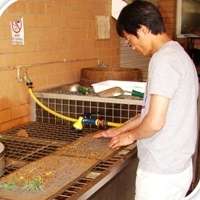Getting to the root of better crops

(Phys.org) —The more crop scientists know about how plant roots take up water and nutrients, the better able they will be to develop crop plants with roots that can cope with challenging soil and environmental conditions.
Until now, it was difficult for scientists to observe roots without digging a plant up. But a new study has suggested that it is possible to develop crop varieties for different environments by using a combination of plant selection and computer simulation modelling.
In a study published in the journal Plant and Soil last week, researchers from The University of Western Australia, the Department of Agriculture and Food WA and institutions in Tasmania and Germany compared modelling simulations with experimental results in a glasshouse.
They observed root growth and root responses to phosphorus fertiliser in narrow-leafed lupin genotypes which had different root traits.
The researchers showed that a combination of phosphorus foraging strategies - including root architecture, root hairs and root growth plasticity - are important for efficient phosphorus uptake from a localised source of phosphorus.
They noted there was a good correspondence between the glasshouse results and computer simulations, confirming the importance of 3-D models of root architecture and function in predicting the optimal combination of root traits for specific environments.
Narrow-leafed lupin was used in the study as it is an important legume for sustainable farming in the Mediterranean climatic region. Scientists have established a large germplasm pool of wild narrow-leafed lupin that contains a significant proportion of the world's genetic resource for developing improved varieties.
"Given the variability in the genome for root architecture, plastic responses and foraging strategies, there is an opportunity to improve crop productivity by selecting for root traits that are beneficial for nutrient and water uptake in the Mediterranean-type environments," the study authors write.
They added that although simulation models do not always predict experimental results accurately, they are very good at predicting relative differences and therefore can be used as a valuable tool for identifying plant phenotypes with improved productivity in the field.
Provided by University of Western Australia



















